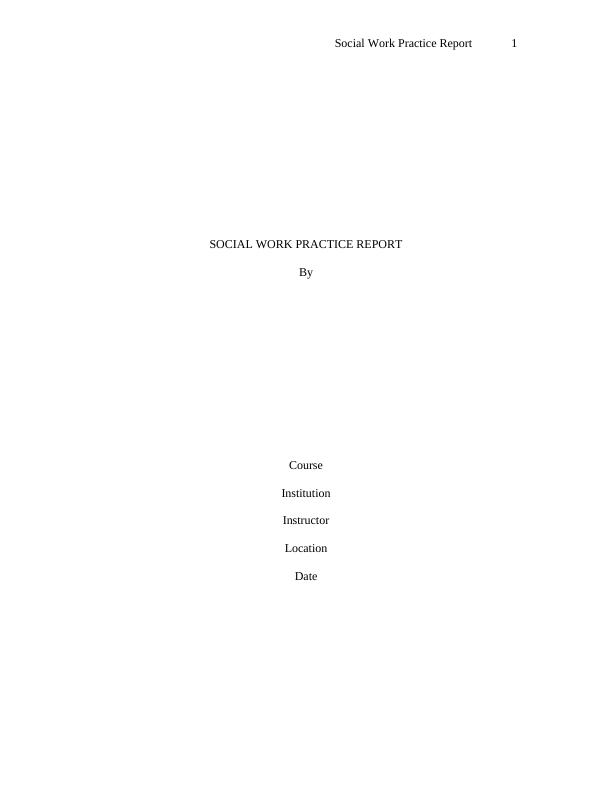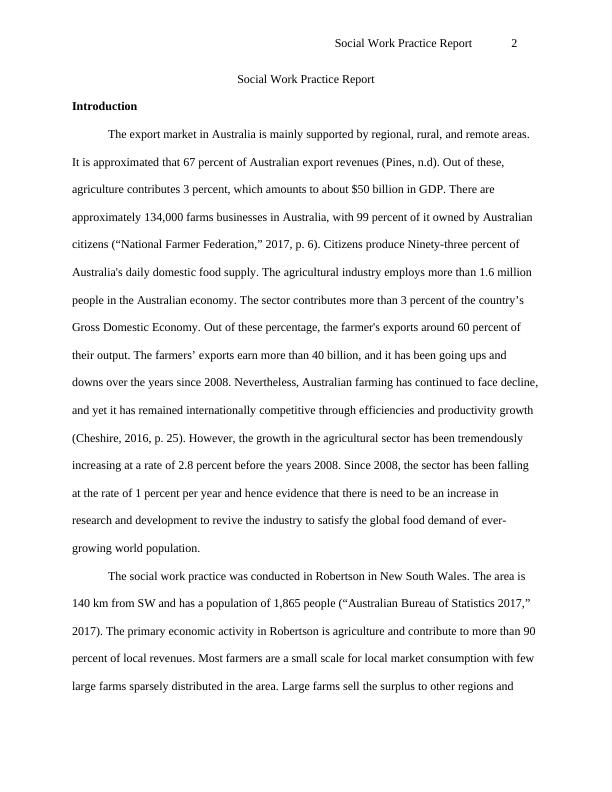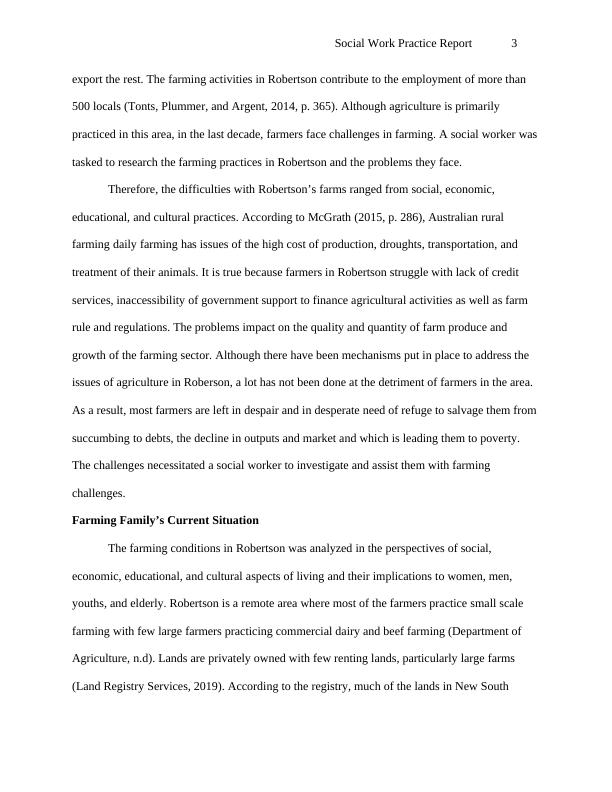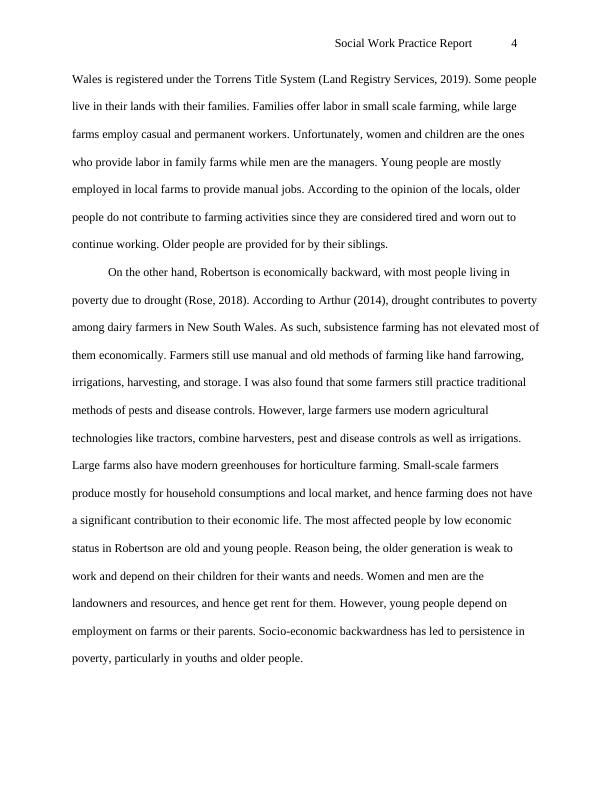Social Work Practice Report
Added on 2023-03-30
14 Pages3579 Words144 Views
Social Work Practice Report 1
SOCIAL WORK PRACTICE REPORT
By
Course
Institution
Instructor
Location
Date
SOCIAL WORK PRACTICE REPORT
By
Course
Institution
Instructor
Location
Date

Social Work Practice Report 2
Social Work Practice Report
Introduction
The export market in Australia is mainly supported by regional, rural, and remote areas.
It is approximated that 67 percent of Australian export revenues (Pines, n.d). Out of these,
agriculture contributes 3 percent, which amounts to about $50 billion in GDP. There are
approximately 134,000 farms businesses in Australia, with 99 percent of it owned by Australian
citizens (“National Farmer Federation,” 2017, p. 6). Citizens produce Ninety-three percent of
Australia's daily domestic food supply. The agricultural industry employs more than 1.6 million
people in the Australian economy. The sector contributes more than 3 percent of the country’s
Gross Domestic Economy. Out of these percentage, the farmer's exports around 60 percent of
their output. The farmers’ exports earn more than 40 billion, and it has been going ups and
downs over the years since 2008. Nevertheless, Australian farming has continued to face decline,
and yet it has remained internationally competitive through efficiencies and productivity growth
(Cheshire, 2016, p. 25). However, the growth in the agricultural sector has been tremendously
increasing at a rate of 2.8 percent before the years 2008. Since 2008, the sector has been falling
at the rate of 1 percent per year and hence evidence that there is need to be an increase in
research and development to revive the industry to satisfy the global food demand of ever-
growing world population.
The social work practice was conducted in Robertson in New South Wales. The area is
140 km from SW and has a population of 1,865 people (“Australian Bureau of Statistics 2017,”
2017). The primary economic activity in Robertson is agriculture and contribute to more than 90
percent of local revenues. Most farmers are a small scale for local market consumption with few
large farms sparsely distributed in the area. Large farms sell the surplus to other regions and
Social Work Practice Report
Introduction
The export market in Australia is mainly supported by regional, rural, and remote areas.
It is approximated that 67 percent of Australian export revenues (Pines, n.d). Out of these,
agriculture contributes 3 percent, which amounts to about $50 billion in GDP. There are
approximately 134,000 farms businesses in Australia, with 99 percent of it owned by Australian
citizens (“National Farmer Federation,” 2017, p. 6). Citizens produce Ninety-three percent of
Australia's daily domestic food supply. The agricultural industry employs more than 1.6 million
people in the Australian economy. The sector contributes more than 3 percent of the country’s
Gross Domestic Economy. Out of these percentage, the farmer's exports around 60 percent of
their output. The farmers’ exports earn more than 40 billion, and it has been going ups and
downs over the years since 2008. Nevertheless, Australian farming has continued to face decline,
and yet it has remained internationally competitive through efficiencies and productivity growth
(Cheshire, 2016, p. 25). However, the growth in the agricultural sector has been tremendously
increasing at a rate of 2.8 percent before the years 2008. Since 2008, the sector has been falling
at the rate of 1 percent per year and hence evidence that there is need to be an increase in
research and development to revive the industry to satisfy the global food demand of ever-
growing world population.
The social work practice was conducted in Robertson in New South Wales. The area is
140 km from SW and has a population of 1,865 people (“Australian Bureau of Statistics 2017,”
2017). The primary economic activity in Robertson is agriculture and contribute to more than 90
percent of local revenues. Most farmers are a small scale for local market consumption with few
large farms sparsely distributed in the area. Large farms sell the surplus to other regions and

Social Work Practice Report 3
export the rest. The farming activities in Robertson contribute to the employment of more than
500 locals (Tonts, Plummer, and Argent, 2014, p. 365). Although agriculture is primarily
practiced in this area, in the last decade, farmers face challenges in farming. A social worker was
tasked to research the farming practices in Robertson and the problems they face.
Therefore, the difficulties with Robertson’s farms ranged from social, economic,
educational, and cultural practices. According to McGrath (2015, p. 286), Australian rural
farming daily farming has issues of the high cost of production, droughts, transportation, and
treatment of their animals. It is true because farmers in Robertson struggle with lack of credit
services, inaccessibility of government support to finance agricultural activities as well as farm
rule and regulations. The problems impact on the quality and quantity of farm produce and
growth of the farming sector. Although there have been mechanisms put in place to address the
issues of agriculture in Roberson, a lot has not been done at the detriment of farmers in the area.
As a result, most farmers are left in despair and in desperate need of refuge to salvage them from
succumbing to debts, the decline in outputs and market and which is leading them to poverty.
The challenges necessitated a social worker to investigate and assist them with farming
challenges.
Farming Family’s Current Situation
The farming conditions in Robertson was analyzed in the perspectives of social,
economic, educational, and cultural aspects of living and their implications to women, men,
youths, and elderly. Robertson is a remote area where most of the farmers practice small scale
farming with few large farmers practicing commercial dairy and beef farming (Department of
Agriculture, n.d). Lands are privately owned with few renting lands, particularly large farms
(Land Registry Services, 2019). According to the registry, much of the lands in New South
export the rest. The farming activities in Robertson contribute to the employment of more than
500 locals (Tonts, Plummer, and Argent, 2014, p. 365). Although agriculture is primarily
practiced in this area, in the last decade, farmers face challenges in farming. A social worker was
tasked to research the farming practices in Robertson and the problems they face.
Therefore, the difficulties with Robertson’s farms ranged from social, economic,
educational, and cultural practices. According to McGrath (2015, p. 286), Australian rural
farming daily farming has issues of the high cost of production, droughts, transportation, and
treatment of their animals. It is true because farmers in Robertson struggle with lack of credit
services, inaccessibility of government support to finance agricultural activities as well as farm
rule and regulations. The problems impact on the quality and quantity of farm produce and
growth of the farming sector. Although there have been mechanisms put in place to address the
issues of agriculture in Roberson, a lot has not been done at the detriment of farmers in the area.
As a result, most farmers are left in despair and in desperate need of refuge to salvage them from
succumbing to debts, the decline in outputs and market and which is leading them to poverty.
The challenges necessitated a social worker to investigate and assist them with farming
challenges.
Farming Family’s Current Situation
The farming conditions in Robertson was analyzed in the perspectives of social,
economic, educational, and cultural aspects of living and their implications to women, men,
youths, and elderly. Robertson is a remote area where most of the farmers practice small scale
farming with few large farmers practicing commercial dairy and beef farming (Department of
Agriculture, n.d). Lands are privately owned with few renting lands, particularly large farms
(Land Registry Services, 2019). According to the registry, much of the lands in New South

Social Work Practice Report 4
Wales is registered under the Torrens Title System (Land Registry Services, 2019). Some people
live in their lands with their families. Families offer labor in small scale farming, while large
farms employ casual and permanent workers. Unfortunately, women and children are the ones
who provide labor in family farms while men are the managers. Young people are mostly
employed in local farms to provide manual jobs. According to the opinion of the locals, older
people do not contribute to farming activities since they are considered tired and worn out to
continue working. Older people are provided for by their siblings.
On the other hand, Robertson is economically backward, with most people living in
poverty due to drought (Rose, 2018). According to Arthur (2014), drought contributes to poverty
among dairy farmers in New South Wales. As such, subsistence farming has not elevated most of
them economically. Farmers still use manual and old methods of farming like hand farrowing,
irrigations, harvesting, and storage. I was also found that some farmers still practice traditional
methods of pests and disease controls. However, large farmers use modern agricultural
technologies like tractors, combine harvesters, pest and disease controls as well as irrigations.
Large farms also have modern greenhouses for horticulture farming. Small-scale farmers
produce mostly for household consumptions and local market, and hence farming does not have
a significant contribution to their economic life. The most affected people by low economic
status in Robertson are old and young people. Reason being, the older generation is weak to
work and depend on their children for their wants and needs. Women and men are the
landowners and resources, and hence get rent for them. However, young people depend on
employment on farms or their parents. Socio-economic backwardness has led to persistence in
poverty, particularly in youths and older people.
Wales is registered under the Torrens Title System (Land Registry Services, 2019). Some people
live in their lands with their families. Families offer labor in small scale farming, while large
farms employ casual and permanent workers. Unfortunately, women and children are the ones
who provide labor in family farms while men are the managers. Young people are mostly
employed in local farms to provide manual jobs. According to the opinion of the locals, older
people do not contribute to farming activities since they are considered tired and worn out to
continue working. Older people are provided for by their siblings.
On the other hand, Robertson is economically backward, with most people living in
poverty due to drought (Rose, 2018). According to Arthur (2014), drought contributes to poverty
among dairy farmers in New South Wales. As such, subsistence farming has not elevated most of
them economically. Farmers still use manual and old methods of farming like hand farrowing,
irrigations, harvesting, and storage. I was also found that some farmers still practice traditional
methods of pests and disease controls. However, large farmers use modern agricultural
technologies like tractors, combine harvesters, pest and disease controls as well as irrigations.
Large farms also have modern greenhouses for horticulture farming. Small-scale farmers
produce mostly for household consumptions and local market, and hence farming does not have
a significant contribution to their economic life. The most affected people by low economic
status in Robertson are old and young people. Reason being, the older generation is weak to
work and depend on their children for their wants and needs. Women and men are the
landowners and resources, and hence get rent for them. However, young people depend on
employment on farms or their parents. Socio-economic backwardness has led to persistence in
poverty, particularly in youths and older people.

End of preview
Want to access all the pages? Upload your documents or become a member.
Related Documents
Assignment On Economics And International Tradelg...
|12
|2947
|35
Economics and International trade assignmentlg...
|14
|3480
|33
Agriculture Assignment: Reforms In Australialg...
|8
|1486
|96
Growth in Australian Agriculture Sector - Assignmentlg...
|9
|1211
|403
Growth of Export Market in Australian Agricultural Sectorlg...
|11
|1554
|218
Industry Reforms in Agriculture Industry in Australia - PDFlg...
|14
|3191
|36
